How young Americans are set to change the US forever
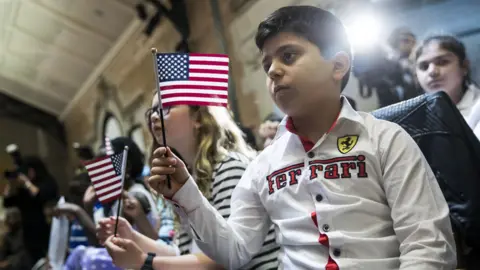 Getty Images
Getty ImagesOlder white Americans still hold most of the economic and political power in the US. But the great ethnic diversity of younger generations means that change is coming.
America's workforce, politics and place on the world stage will soon be changed forever.
So great and so rapid are the shifts in the country's population, that, in the coming decade, the US is set to be transformed far more than other nations.
Almost half of millennials and children are from ethnic minority groups and it is this great diversity that is at the heart of demographic changes.
As the country comes to rely on them for its future prosperity, everyone will have to consider how society must change to make a success of this new reality.
A fearful generation
Donald Trump rode into the White House on a wave of support from older white Americans - those over the age of 45.
Many were drawn to his promise of creating a better economy.
But part of Mr Trump's appeal was his stance on growing immigrant populations and political correctness.
His position reflected the fears of some older white people - part of a cultural generation gap identified by national polling in recent years.
 Getty Images
Getty ImagesMore than half of white baby boomers and older Americans questioned for a 2011 survey by the Pew Research Center saw the growing numbers of newcomers from other lands as a threat to American values and customs.
And older white Americans were found by a 2015 PRRI poll to be more likely than younger generations to think the country's culture and values are worse today than in the 1950s.
Yet despite their fears, the economic well-being of the nation may well hinge on this younger and more diverse population.
A rapidly ageing white population
The white population of the United States will soon be on the decline.
The median age of whites - the point at which half the population is older and half younger - is now 43.
Among Hispanic Americans, the nation's largest minority, the median age is 29; while it is 20 for mixed race Americans, the fastest growing minority.
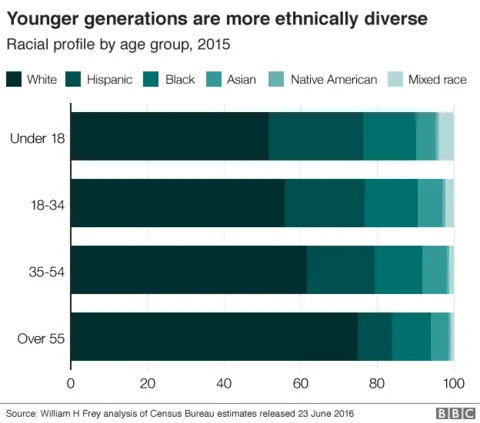
In eight years' time, America's white population is expected to start falling, as the number of people dying exceeds the number of births.
Already, the number of white under-18s is falling - a pattern which will continue because of a decline in the population of white women of childbearing age.
Most striking of all, perhaps, is the speed at which the white population is ageing.
By 2030, the number of white over-65s will have grown by 42%.

More from the BBC

At the same time, the number of white people of working age will have grown by only 9%.
The reality is that America will soon have large numbers of older white people dependent on the support of younger, more diverse, generations.
The support of younger workers
In the near future, the majority of children born in the US will be from ethnic minorities.
Already, minorities make up nearly half of American youth; and, as white baby boomers retire, minorities - particularly Hispanics - will account for all the growth in the US workforce.
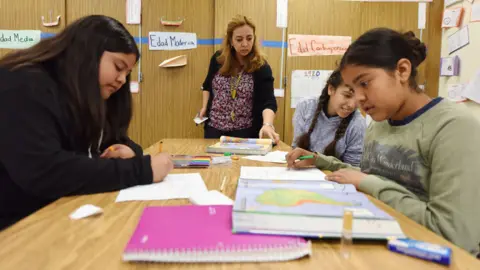 Getty Images
Getty ImagesIt is their contributions to economic growth, to tax revenues, pensions and old age medical insurance that will be relied upon.
These demographic facts raise important questions about how government spending should be allocated.
Currently, large numbers of minority children in the US attend under-resourced schools.
Four-year college enrolment for Hispanics and black people, while rising, continues to stand well below that of whites.
Many lack the finances and guidance they need to secure middle class jobs.
Income inequality has hit minority youth particularly severely and threatens to lead to continued inequality in the future.
A nation in need of youth
Young generations of "new minorities" - Hispanics, Asians, and multiracial Americans - are interacting with older minorities and white Americans, as they pursue opportunities in a country that is in dire need of more youth.
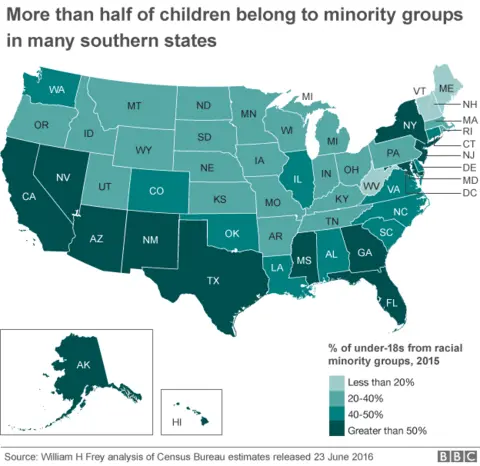
This "just in time" population boost comes from recent immigration and somewhat higher birth rates.
The states that are benefitting most are in the south and west of the US - where minorities have bolstered the gains in the child populations.
In contrast, many states in the nation's Northeast and Midwest are facing losses in their mostly white child populations, which are not being replaced by the births and in-migration of young minorities.
Looking outside the US
This surge in the number of young workers leaves the US in a much better position than many other industrialised nations.
The population of the US - about 325 million people - has risen by nearly 100 million since 1980.
It is expected to rise to 400 million by the middle of the century - a very different scenario to that projected for most of the developed world.
For example, compared with Japan, Germany, Italy and the United Kingdom - countries with generally older populations, lower birth rates, and lower immigration - the US working age population is expected to grow faster: by more than 5% between 2010 and 2030.
This population growth will, in turn, help to power America's economy - increasing production, consumption and entrepreneurial opportunities.
Yet were it not for its youthful new minorities - Hispanic and Asian Americans - the country's workforce would actually decline.
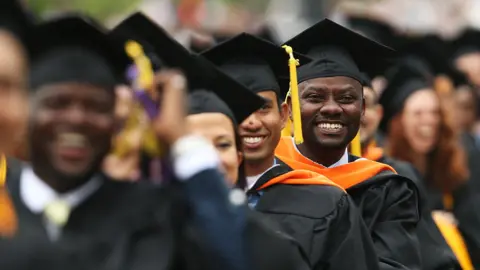 Getty Images
Getty ImagesNew minorities may also offer the youthfulness that can bring energy, innovation and an entrepreneurial spirit.
The cusp of great change
Although the present culture gap between the generations may persist in the short run, the reality of America's changing population is likely to mean that "demography is destiny".
The "diversity explosion" that the nation is now experiencing will alter all aspects of society.
Leaders at all levels of government - and Americans in general - will have to consider what investments are needed in today's young minorities to help the country prosper.
The United States - much more than its peers - is on the cusp of great change.

About this piece
This analysis piece was commissioned by the BBC from an expert working for an outside organisation.
William H Frey is a senior fellow at the Brookings Institution and author of Diversity Explosion: How New Racial Demographics Are Remaking America.
The Brookings Institution describes itself as a not-for-profit public policy organisation, conducting research that leads to new ideas for problems facing society.

